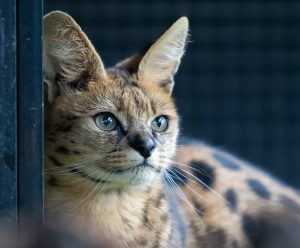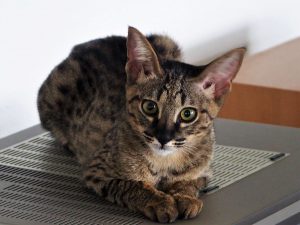The first generation of Savannahs are commonly known as the Filial Savannahs. You can see that the term F1, F2, F3, F4 etc. is used. The “F” does not stand for Foundation, as many people think, but for Filial (Generation). F1 (Filial 1) means one generation from something, F2 means two generations from something, F3 means three generations from something, etc.
The Savannah cat’s Foundation is the Serval.
The Serval is the ancestor of the Savannah cat. The Serval was crossed with an ordinary domestic cat and the first Savannah was created in 1986.
The generations of Savannah in percentages
In the case of the Savannah breed, the term Filial is used to show the number of generations of the Savannah cat, how far the Savannah is from the Serval (the Foundation cat). When we talk about F1 we are talking about a Savannah whose father is a Serval. The mother cat (it doesn’t matter which generation it is) is therefore covered by a Serval. The cat is therefore the 1st generation after the Serval.
When we talk about an F2 Savannah, we are talking about a cat whose grandfather is a Serval. The mother cat herself is an F1 Savannah and has been covered to a Savannah male (from F5). For the percentage of Serval blood and the size prefer an F5 than a lower generation male. However, it remains an F2 Savannah, even when covered by an F7. When we talk about an F3 Savannah, we are talking about a cat whose great-grandfather is a Serval. The mother is an F2 Savannah. Each generation of Savannah therefore contains different percentages of Serval blood.
Savannah F1 in percentages
A Serval with an F1 Savannah gives a much higher percentage of Serval blood than a Serval with a domestic cat. A domestic (Savannah) cat has about 12% (from F5, Dutch law) to 0% Serval blood (other breed). Have this covered by a Serval then you will have at most an F1 Savannah with 56% Serval blood. With a cross between a Serval and an F1 Savannah you can breed an F1 with 75% Serval blood. If this F1 is also covered by a Serval, the percentages will be even higher.
These Savannah cats are larger and closer to the Serval. They also look more like their ancestors in character and appearance. However, for a Savannah with 75% Serval blood (or higher), they are more difficult to keep in the house, because the Serval’s behavior is also 75% bred back into the cat, such as spraying behavior and dominance.

F1 Savannah is difficult to breed
Dedicated breeders today have to make sure that the breed is further improved by only breeding a Savannah x Savannah. F1 Savannahs are rare and cost a lot of money. The initial cross between Serval and domestic cat is difficult, given the big difference in size between the 2 cats. There is also a difference in gestation period between a Serval and a domestic cat (65 days for the latter and 66-77 days for the Serval). As a result, some F1 kittens can be born prematurely and require day and night care.
What does “the letter” after the generation F1, F2, F3 etc. mean?
- A = Savannah x Outcross (one parent is a Savannah)
- B = A Savannah x A, B , C or SBT Savannah (Parents are Savannahs)
- C = B Savannah x B, C or SBT Savannah (Parents and grandparents are Savannahs)
- SBT = C Savannah x C or SBT Savannah and SBT x SBT (Parents, grandparents and great-grandparents are Savannahs)
SBT means “Stud Book Tradition” and purebred according to TICA. At least three generations (parents, grandparents, and great-grandparents) must be exclusively Savannahs. This is obviously not possible with F1-F3 cats, which is why they are called “Foundation” and cannot be shown regularly. An F1 is always A registered, F2 can be F2 A or F2 B and F3 can be F3 A, B or C. An SBT Savannah cat is therefore only possible from F4.
A breeder receives a pedigree certificate from the studbook association for his or her kittens if these are A to C (experimental) and a pedigree if the kittens are SBT.
A registered Savannah SBT is allowed to participate in cat shows organized by TICA because it has achieved “Championship Status”. The WCF has also recognized the Savannah as a breed. The FNK and the FIFe have not recognized the Savannah cat, but there the breed can participate in cat shows in the domestic cat class.

Aim Savannah Breeder
The aim of a good Savannah breeder is to breed a beautiful and large Savannah cat with a bit of Serval character and then fully domesticated. So we are trying to breed a domestic cat, which looks like an African Serval and has left behind all the negative qualities of the Serval. With negative characteristics we are talking about the natural traits of a Serval, which we would rather not see in the house. Examples are, marking its territory with urine (spraying) or chewing the piece of the couch, because it resembles soft prey.
While all generations of Savannah females generally appear to be fertile, the males are sterile (infertile) until the fifth generation (F5). All males F1 to F4 should be neutered and sold as pets. With the exception of exceptions, it sometimes happens that an F4 male appears to be fertile.
Savannah females are covered to an F5 male (or lower generations F6, F7, etc.) or another domestic breed eg Oriental Shorthair, Ocicat, Egyptian Mau and European Shorthair. These cats are recognized by TICA as permitted breeds. Beautiful cats were also obtained by crossing with Serengetis, Bengals and even Maine Coons (for size) just to name a few. However, these breeds are no longer allowed to cross with a Savannah cat since 2012.
